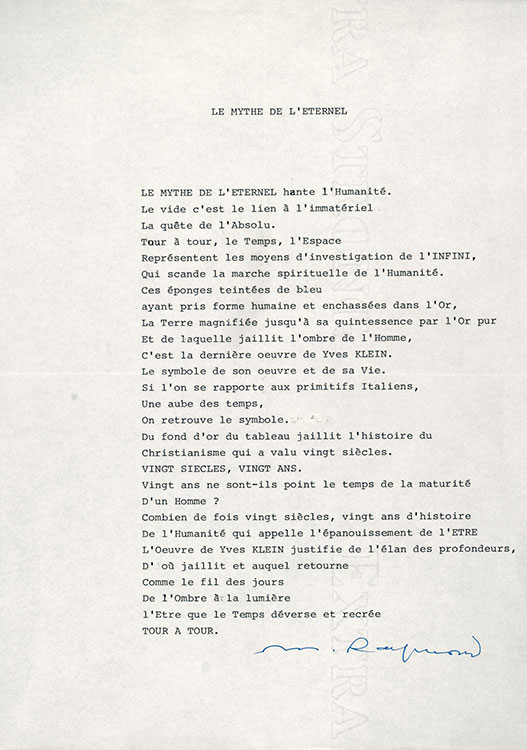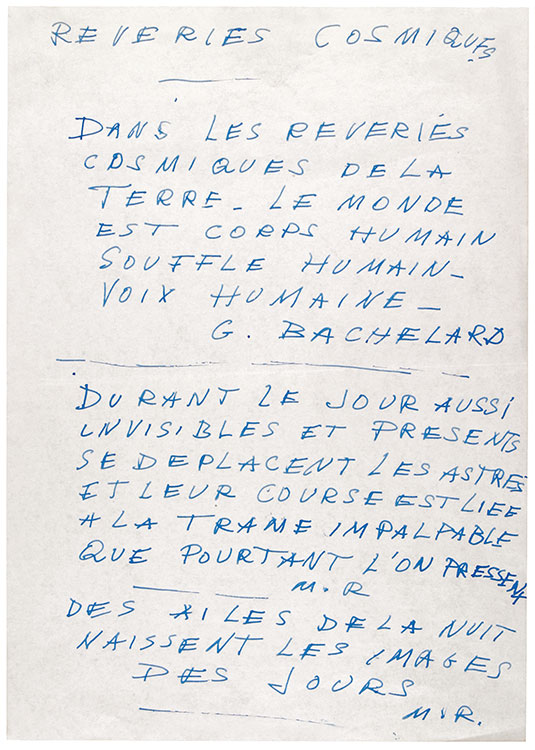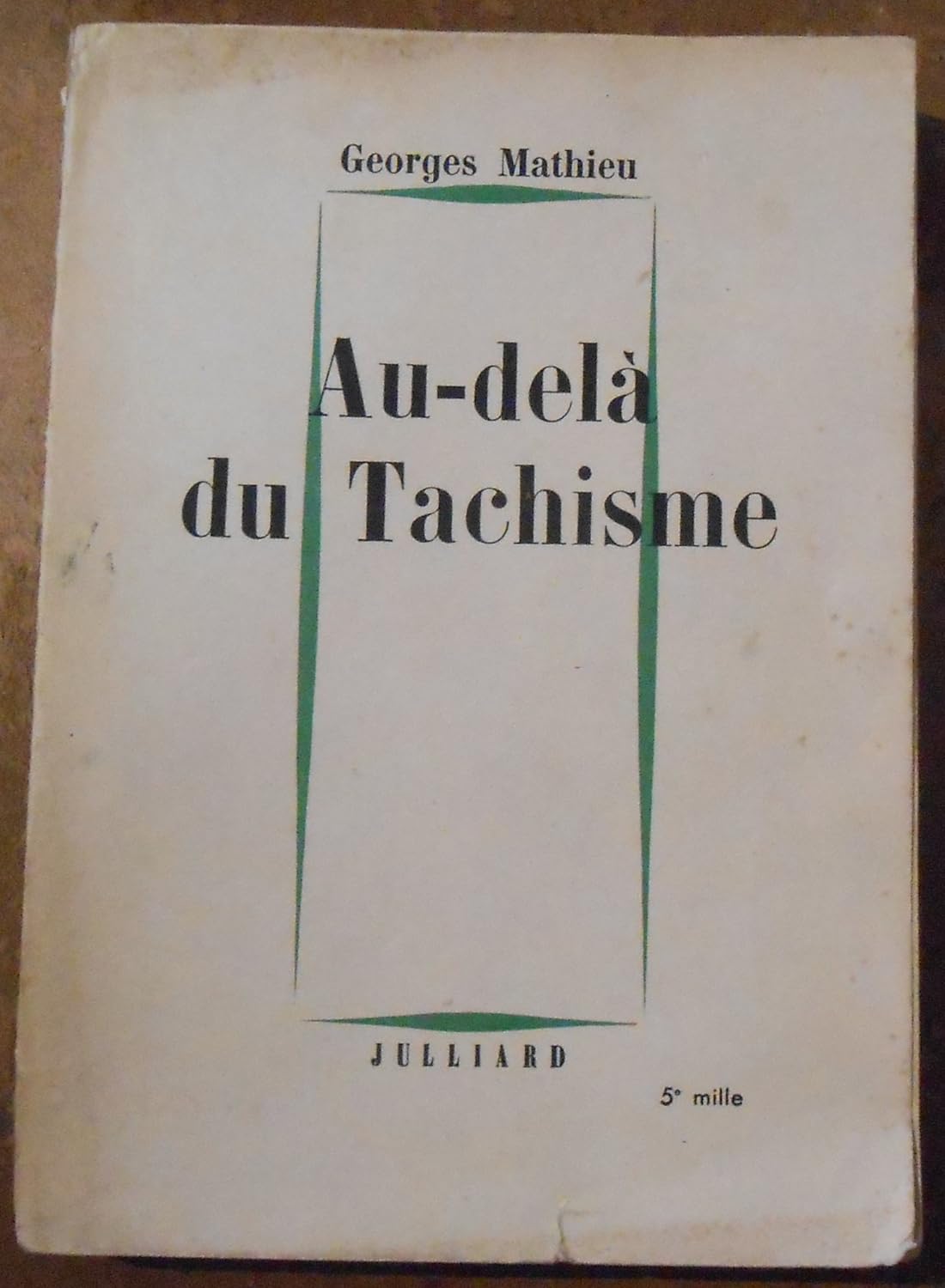DOCUMENTS
The Myth of the Eternal
Undated tapuscript, 1980’s
The MYTH OF THE ETERNAL haunts humanity.
The void is the link to the immaterial
The quest for the ABSOLUTE.
In turn, Time and Space
Represent the means of investigation of the INFINITE,
Which chants the spiritual march of Humanity.
These sponges tinted blue
having taken human form and enshrined in Gold,
The Earth magnified to its quintessence by pure Gold
And from which springs the shadow of Man,
This is the last work of Yves KLEIN.
The symbol of his work and his Life.
If we refer to the Italian Primitives,
A dawn of time,
We find the symbol.
From the painting’s gold background springs forth the history of
Christianity which is equivalent to twenty centuries.
TWENTY CENTURIES, TWENTY YEARS.
Do twenty years not mark the time of maturity
Of a Man?
How many times twenty centuries, twenty years of the history
Of Humanity that appeals to the blossoming of the BEING
The Work of Yves KLEIN justifies the impulse of the depths,
From which springs forth and to which returns
Like the passing of the days
From Shadow to light
The Being that Time pours out and recreates
TURN BY TURN.
- Marie Raymond

Poem by Marie Raymond
Undated Tapuscript, 1980's
Archives Yves Klein, Paris
Créer pour voir
Published in Témoignages pour l’art abstrait, Boulogne, Art d’Aujourd’hui, 1952, p. 241-242
"Life slides into things and light makes it sensible to us. In the light, images are born that are mirrors of the inner self and that place before our eyes, within reach of our senses, a fiction that contains the details and the whole, the interior and the exterior, the desires and the realities, that thoughts are made of, the ideas (the thrust of vitality that has taken shape in the dream), the power that creates the spiritual forms from which the constant process of becoming is nourished.
I glance into this world of dreams and the earth fades away, the horizon fades away, and the beings alone remain, flushed with the rays that the long days passed cast upon their faces, like worlds, individuals that crush and pierce the space with their weight and move around the skies and surrounding air. Everything there seems to play in slow motion so as not to break this atmosphere so light… that it seems unable to support the weight of the bodies. The forms are in suspense, and in time, which grows weary, and catches the clear and vibrant rays of the evening through its forms, the soul of the landscapes mingles with our soul, and contains both anguish and gentleness.”
- Marie Raymond
Manuscrit sur l’art
UNDated Writings of Marie Raymond
“However vast the movement of humanity and its surroundings may seem, every detail can tell its story, every error confirms the truth.”
- Marie Raymond
Ce que je voudrai être
Undated Poetry By Marie Raymond
Je voudrais être un rayon,
un rayon qui réchauffe,
un simple rayon
qui pénètre curieux, lumineux,
remarqué et aussi souhaité.
Si on me demandait ce que je voudrais être,
inconnu et présent, insaisissable, serein et joyeux,
un rayon qui vient à la rencontre. Du lointain au point juste.
J’aurais franchi l’Espace.
Il me serait facile de fureter,
de découvrir, de caresser, d’être vu.
Jamais saisi, jamais souillé, je serais pur et pourtant je saurais.
Je saurais qu’on m’aime, j’aimerais.
Ce serait bon d’être un rayon. Venu du Soleil même,
mais un rayon tout rond.
Par le même chemin je reviendrais là-haut,
puis, descendrais encore, inlassablement.
La Terre tournerait, bien sûr.
Alors, je chercherais, là-bas, au-delà de l’ombre.
Je sourirais toujours.
Portée par l’air, sondant le Temps,
je pourrais tout connaître.
Et mon identité, pareille à tant d’autres,
serait ici ou là, solitaire et multiple,
à tous les autres uni
et cependant unique
Si j’étais un rayon !
- Marie Raymond
Cosmic REVERIES
Notes by Marie Raymond about Gaston Bachelard, undated manuscript
In the cosmic reveries of the Earth, the world is a human body, a human breath, a human voice. – G. Bachelard
During the daytime, the invisible and ever-present stars travel and their course is connected to an impalpable framework that can nonetheless be sensed. – M.R
From the wings of the night are born the images of the days. – M.
- Marie Raymond

Notes by Marie Raymond about Gaston Bachelard
Undated Manuscript
Archives Yves Klein, Paris
Towards Becoming Published
Kroniek van Kunst een Kultuur, 1948
It needs so many millions of beings, so many pairs of eyes, and so many hearts, the world, to examine, down to its most infinitesimal secrets, this impetus for life that pushes it to act. It listens, it watches, it resonates, and it creates. It must adjust, combine, and sort through the chaos to find the things that are in agreement, the seeds that will germinate. The world must feel itself vibrate, be conscious, and build unity out of what is scattered and disparate, to lift the weight of matter that draws it to the ground. It must rely on these “nothings” that will be able to maintain its balance. As such, it rolls through the universe, supported by the ethereal atmosphere that surrounds it. It is a nothing, a hollow, a hole, this vibrant space, the supporting structure of our Earth. This “nothing” is a weight that balances our earthly weight; it is, therefore, strong enough. Space, the void evident between things, between atoms, the fabric of infinity.
Creating means adding weight to the weight of the world; it means making it heavier. And so the world has become heavy with its research, its progress, its discoveries, its peoples. Heavy with its unbalanced past, it lacks air, as it were, to support the weight of its riches. And so we see it trying to appropriate space through science.
A tree grows tall because of both its roots and its branches, and the space it takes in the air, which is larger and more extensive than the space it takes on the ground, widens and opens up, maintaining its balance. For thousands of years, the call of the beyond, the escape of the spirit, and the effort to soar through thought had been enough for our soil. Could it be a lesser effort to force science to seek this support? Could it be that in the interest of compensation, it should reduce the loftiness of its thinking for the vanity of actually being able to soar? Could it be a vain love of life that impels me to think that this effort towards matter, this concentration of thought on earthly things, is only an expansion of the roots of an enlarged evolution?
I will content myself with clarifying the faith that supports me in this certainty. So, perhaps this movement of the art of our time would be justified, a stigma of thoughts aimed at expressing nothings, at creating spaces in which our inner being is in a position to find the rest, the assistance which will ensure its respiration, its ethereal support.
- Marie Raymond
Foreword in Beyond Tachism
by Georges Mathieu, 1963
What is history? Events from a certain period of time as qualified by the storyteller. This is how Mathieu describes the history of post-war painting
However, the personal viewpoint should not be tainted by oversights, which can hinder the actual facts. Imprints as promoted by Yves Klein are nowhere mentioned, which identify and are similar to prehistory of a future, and are moving evidence of the actual existence, through which the internal vacuity preceding creation is highlighted. Whereas Mathieu’s painting reveals a visionary and quite genuine outburst, his book seems to be tainted by all that hinders that outburst.
In any case, it is still an interesting record. One can feel the painter’s anxiety calling for the materialisation of the signs forwarded by the instant, a weird need for communion which justifies his public displays like an actor. It is all about a “mental approach to the right to improvise”, i.e. about the cosmic relation which can be reached through the pace of the escape, but with all the potential risk involved: “from thousands of years to the untainted instant”! The link with the spontaneity of the Far-East calligraphers reveals another stage of the re-emerging deep connections between the East and the West. The means to achieve the grip on the Universe are no longer only based on reason, on senses.
The passive area, so dear to our times, is enhanced by the craving for creation, and is the error, - the stain – not the ferment of eternal life, beyond tachism of course?
VALUE: The purpose of writing this book is to justify the position of the artist and to promote it. Does this justification requirement not encompass doubt? A requirement for any human accomplishment to bridge the gap towards the intangible, which Mathieu bases on sculptor Nevelson’s poetic, and the expression power of which he unveils through a lot of “nothings” gathered into a Whole.
- Marie Raymond

Meeting The REal
UNDATED Writtings
If out of the original magma the Universe gushed forth because beheld potentially within; if structure did allow the differentiation of germs and the elaboration of Destiny; if, from the atom till the macrocosm Everything is constructed, organized, devised, as does the computer containing and developing myriads (miriades) of combinations, the complete sequence of a primary thought.
The drop of water, the pearl, the questioning aimed at the immaterial informal, exude and penetrate the secret. Everything and nothing become confused and an image bursts forth.
READ MORE...
The famous story of the egg and the chicken ever repeats itself with the same questioning from Era by era in the way waves do when covering one another according to the moon gravitational force. The droplets break out to then go back to the expanse. The sea is altogether reality, life and mystery. It’s a world of its own that takes up the greatest portion of the globe, has its own rules and sweeps away our dreams. Isn’t it that kind of dream that emerges from all-time art and its approval–the human being either hovers above his origins, either tunes in, either goes out of tune and sprawls as to reform his vision and confront it to the Whole he stems from.
A painting, a work of art, bear the mark of an era, a period of time, as to allow its insertion within the endless movement. It becomes a finished and containing object, like every individual, like all things create the shape of their vision and their connection to time. In this way do the different civilizations, landmarks of the covered Space determine themselves. Humanity having in this way expressed by its works the marks of its thoughts. It would be possible to detect mark by mark what motivated mankind in its sensations, visions, organization…
If for instance during the 17th century the search for the chiaroscuro haunted imagination and allowed to give as exact copy the conception of the world at that period, it’s thanks to Rembrandt on the one hand and Vermeer on the other, that we have the chance to still live through the thoughts of that time. A summit within the history of everyday life, reaching a perfection Vermeer proved by inserting the daily gesture of The lacemaker, The love letter, within the puzzle of time. Reality sticks to Time and Space– an ideal Whole. Rembrandt, through his chiaroscuro technique, gives of this period a vision of light which indiscriminately lays down on the individuals or things, here and there, according to the fancy of his gesture (chance, necessity). The structure of society was at the time divided: the masses and the lords. An individual similar to others is put forth in the light, whereas the masses stay within the shade of the unknown, when the thoughts of this great painter are enlightened by the painting’s layout and the subjects he treats, ordering thoughts and their social order. Each painting is a problem and an achievement of pure perfection. “The Anatomy Lesson of Dr. Nicolaes Tulp”, “The Jewish bride”; “The night watch” ordered by a society whose aim was to show the world the mighty. Through its technique and genius it put to the fore the man with the drum and put aside in the obscurity the conceited societies, leading to the disrepute of the painter and his exile from the society of the time to the benefit of the expression of ideas.
One could in this regard exude the secrets of all societies. During the French Revolution the action does not enable revealing the inner mind still stamped with the structures of the past, especially when the Empire period with Napoleon overwhelms and reintegrates the forces of the past. But what the French Revolution opened was the great and unique era in history of science and its tremendous discoveries that completely changed humanity and made possible its liberation. The impressionists represent the history of light scenery of all beings. Everything is transparent, individualized, strokes of paint, like individuals, separated and united by the eye, the laws of light that need space and distance as to operate the fusion into a Whole of every Being, every instant.
The call of the colours, of the mass it represents constitutes a strength. Every mass constitutes a strength – and here we are in the 20th century. Thought found another master to dominate, the industry which, in order to liberate it, enslaved it and swept it along as a tidal wave would have done. The research wave that tends to instituting it thanks to the cosmic force does risk its annihilation.
In parallel to Impressionists, Cézanne –whose budding structuring attempts to tuning the Being with Space – then thanks to the discovery of African arts where cubism attempts separating and organizing while demonstrating the interpenetration. The fourth dimension that disturbs the insertion of shapes. The time that dissects and kills shapes and beings and for which the constant presence disturbs the quiet happiness.
Yves Klein’s vision of the infinite rebels against intrusive materialism. Space is open to thought, attempts killing and kills. Doesn’t the never-ending bond shorten the shapes created by life? Beauty surrounds us like a temptation. Should we flee or linger? Yves Klein’s « Stop » also contains the momentum (monochrome), the movement, the harmony with the material and the organization: The real and the unreal.
In the same way, in the 17th century the movement of thought is double just like every being is double. Following Cézanne that was already in search for construction, separating the warm from the cold colours, attempting to fulfil this quiet happiness expressed by Vermeer, “Abstract painters” became attached to the construction of the painting, to the strict organization - constructivism- but here again, once more, one cannot keep feelings on a lead, the take off of the soul. Each period has thousands of facets of its own. Therefore, couldn’t abstraction, regulation, lead to the fantastic, to the great mastered myths, following the lessons of Ancient Greeks.
If every period of thought erases the other, the previous one, for the march of time as for the march of the being, couldn’t a step on the right, a step on the left, maintain the equilibrium? As time does, the informal erases the steps and forms the mirror, the monochrome mirror of time within which will be reflected the deepest desire of beings, beyond themselves.
Abstraction allows organizing, driving towards the orthogonal woof of the world that binds it to the Cosmos. Aren’t there on the one hand the cosmic fragrances that penetrate and stimulate feelings, and on the other hand the insertion of the being within the puzzle of time?
Erasing through informality. The Mistake symbolized by the stain, “tachisme”; aren’t the mistake and the stain allowing the change in history of the facts that fall within? The conceptual engenders the idea, the thought that breaks through. Surrealism thanks to poetry, compares and inserts the dream; but the dream, the stain, the organization, the structure, the erasing of past through informality, the lyricism linked to the cosmic. There are so many other forms of investigation that could constitute the thousands of facets which, one after the other and in turn, project their flashes upon the reality of real-time, always imperfect, always stimulated, repeating, as an attempt to snatch from flying time, to tell others the thoughts of everyone, as to bond the invisible to the visible, fragment by fragment, while searching tirelessly to master everything.
I just came up with an idea! Wouldn’t it be that the feminine expression is focused on life, the harmony between beings and things expressed long ago by Vermeer?
The masculine, like time, be the one that concludes in order to compose? And the feminine state be the one that prolongs life through duration? From time immemorial, woman weaves and embroiders and paints, protects the offspring, prolongs life. Man, through war, aimed at conquest and broadening, gives spirit. This double state of mankind through harmony and disharmony transcends time towards the equalization of their forces, within which the transient and already unreal reality will have stamped its mark. But do not they tend one and the other to interfering with their initial tendencies towards an equilibrium of their innate qualities, towards the Androgenic reality of a Future?
- Marie Raymond
Copyright © 2024 ARCHIVES MARIE RAYMOND.
tous droits réservés.
